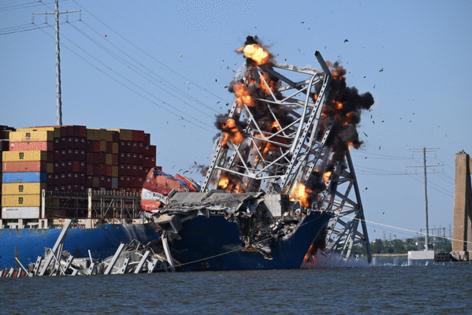Explosives break up Key Bridge section atop Dali, readying to refloat vessel
Published in News & Features
BALTIMORE — There was a boom, several plumes of smoke and then a splash as millions of pounds of Francis Scott Key Bridge debris fell Monday evening into the Patapsco River.
Crews had previously placed linear shaped charges — explosive cutting devices — on the large piece of the bridge that dropped March 26 on the bow of the Dali after the ship struck one of the bridge’s supporting piers. When detonated at 5:01 p.m. Monday, the small explosives sliced the steel into chunks that tumbled into the water.
From nearby Fort Armistead Park, members of the media heard the loud, baritone explosion and observed several simultaneous puffs of smoke. The entire detonation lasted less than 10 seconds.
From an aerial view shown live on television, a large chunk of the bridge appeared to break away from the Dali and slide further into the river. On video, the smoke quickly obscured the flames from the blast, but they could be seen at multiple points on the structure in a photo by a Baltimore Sun photographer.
The 984-foot ship is expected to remain in the river for roughly two more days as it is surveyed. It will then be tugged to the Port of Baltimore’s Seagirt Marine Terminal.
The 21-member crew remained on board, sheltered in place as the explosives were detonated, officials said.
The removal of what officials referred to as Section 4 of the bridge marked a milestone in what has been a massive recovery and salvage operation launched after the catastrophe, which killed six construction workers who were repairing potholes on the span. It was just last week that divers recovered the body of the last victim.
Salvage workers prepared the bridge section for what Key Bridge Unified Command characterized as a surgically precise operation. They analyzed where to install the small explosives, sliced into the steel beams of the truss, dropped in the charges and then encased them with wrapping similar to large pieces of tape.
The controlled explosion was initially scheduled for Saturday, but was delayed when weather affected the preparations. On Sunday afternoon, it was postponed again to the following day. It took place Monday evening to coincide with low tide, and the eventual refloating of the vessel was expected in roughly two days during a high tide.
Anyone within 2,000 yards of the blast site, which included a few businesses on Hawkins Point, was asked to wear ear protection against the sound, which officials compared to a fireworks display or thunder.
...continued
©2024 Baltimore Sun. Visit baltimoresun.com. Distributed by Tribune Content Agency, LLC.







Comments